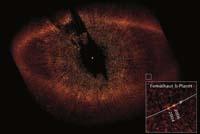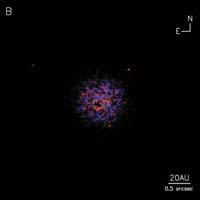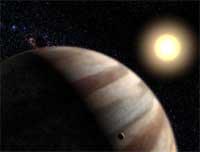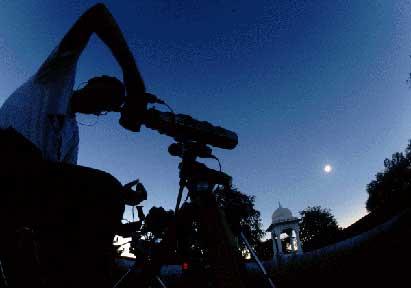Photos of Exoplanets
2009/01/01 Elhuyar Zientzia Iturria: Elhuyar aldizkaria

Astronomers looking for planets outside the Solar System for the first time have managed to see some of them. So far, these exoplanets have been detected by different methods and have spread on several occasions using the word see in the article titles. But in these cases, instead of seeing the planets, they have been detected. Now they have taken pictures of four exoplanets. So you have seen them literally.
Three of these four exoplanets are found around a constellation star of Pegasus, at a distance of 130 light years from Earth. The other is located around the Fomalsel of the constellation of Pisces Austrinus, 25 light-years.
To date, two methods have been used mainly for the detection of exoplanets. The most common thing is to analyze the trajectory of the star in the galaxy: a star without a planet around it makes a direct route, but as a star-planet system is orbiting around the center of masses of both, the movement of the star does not make a correct route, but small leaps. Therefore, around a star that does not make the right path there must be a great exoplanet.
Another common method of detecting exoplanets is the study of the luminosity of the star. If a planet in orbit passes in front of the star, it will hinder light and periodically there will be a small variation in the intensity of light.
Fine techniques

The photograph of an exoplanet requires special techniques. For the three planets of the Pegasus constellation, astronomers at the Herzberg Institute of Astrophysics in Canada have combined two techniques. On the one hand, they have taken pictures in the infrared spectrum. But, on the other hand, using the telescopes on Earth (the pair of Gemini telescopes in Hawaii and Chile, and the Keck telescope in Hawaii), they had to apply an adaptive lens to correct atmospheric distortion. This technique constantly changes the shape of a mirror to compensate for the distortion of small atmospheric changes.
In the case of the constellation of Pisces Austrinus, on the contrary, they have used the Hubble space telescope for direct observation of the star Fomalsel, but they have used the technique of the corography, that is, they have used an instrument that covers the light of the core of the star to be able to see it around it.
Through this set of techniques they have received direct light from some exoplanets. It has been a breakthrough, not only because man wants to see things, but because direct light has a lot of information for scientists. For example, the study of the spectrum of light allows to detect with great reliability the chemical components of the atmosphere of exoplanets.
Astronomers have already detected about 300 exoplanets and currently about 13 exoplanets are detected each year. From now on it is possible that, in addition to exoplanets, images of exoplanets also proliferate.

Gai honi buruzko eduki gehiago
Elhuyarrek garatutako teknologia





